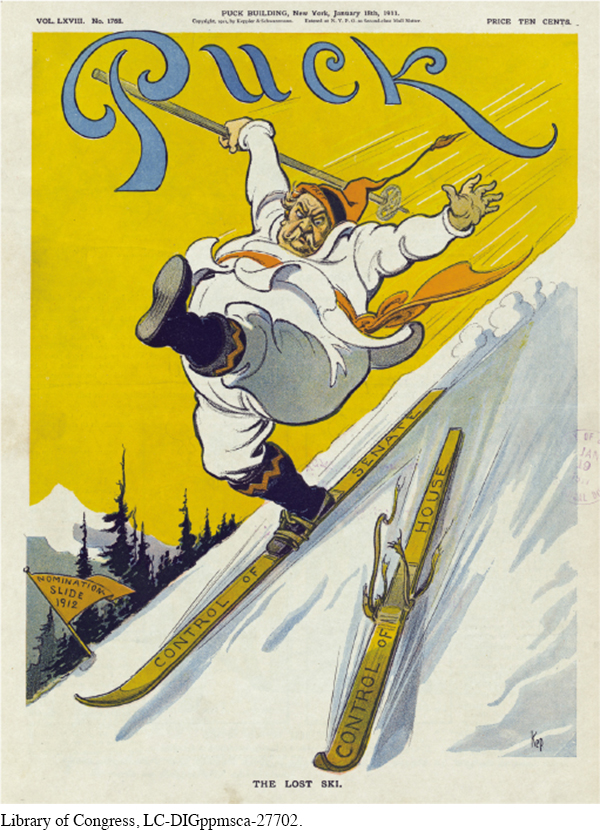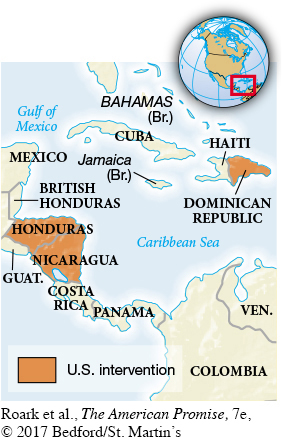The American Promise: Printed Page 603
The American Promise, Value Edition: Printed Page 551
The American Promise: A Concise History: Printed Page 629
The Troubled Presidency of William Howard Taft
Roosevelt promised on the eve of his election in 1904 that he would not seek another term. So he retired from the presidency in 1909 at age fifty and removed himself from the political scene by going on safari in Africa. He turned the White House over to his handpicked successor, William Howard Taft, a lawyer who had served as governor-
A genial man with a talent for law, Taft had no experience in elective office, no feel for politics, and no nerve for controversy. His ambitious wife coveted the office and urged him to seek it. He would have been better off listening to his mother, who warned, “Roosevelt is a good fighter and enjoys it, but the malice of politics would make you miserable.” Sadly for Taft, his wife suffered a stroke in his first months in office, leaving him grieving and without his strongest ally.

Once in office, Taft proved a perfect tool in the hands of Republicans who yearned for a return to the days of a less active executive. A lawyer by training and instinct, Taft believed that it was up to the courts, not the president, to arbitrate social issues. Roosevelt had carried presidential power to a new level, often flouting the separation of powers and showing thinly veiled contempt for Congress and the courts. He believed that the president had the legal right to act as steward of the people, and to do anything necessary “unless the Constitution or the laws explicitly forbid him to do it.” Taft found such presidential activism difficult to condone. Although he pursued the trusts vigorously, he acted more like a judge than a steward. Wary of the progressive insurgents in Congress, Taft relied increasingly on conservatives in the Republican Party. As a progressive senator lamented, “Taft is a ponderous and amiable man completely surrounded by men who know exactly what they want.”
The American Promise: Printed Page 603
The American Promise, Value Edition: Printed Page 551
The American Promise: A Concise History: Printed Page 629
Page 606Taft’s troubles began on the eve of his inaugural, when he called a special session of Congress to deal with the tariff. Roosevelt had been too politically astute to tackle the troublesome tariff issue, even though he knew that rates needed to be lowered. Ida Tarbell, who lent her meticulous research skills to the tariff debate, concluded, “At a time when wealth is rolling up as never before, a vast number of hard-
Taft struggled to transform growing public sentiment against the tariff into legislation. But Taft blundered into the fray. The Payne-
Taft’s legalism soon got him into hot water in the area of conservation. He undid Roosevelt’s work to preserve hydroelectric power sites when he learned that they had been improperly designated as ranger stations. And when Gifford Pinchot publicly denounced Taft’s secretary of the interior as a tool of western land-
The American Promise: Printed Page 603
The American Promise, Value Edition: Printed Page 551
The American Promise: A Concise History: Printed Page 629
Page 607In June 1910, Roosevelt returned to the United States, where he received a hero’s welcome and attracted a stream of visitors and reporters seeking his advice and opinions. Hurt, Taft kept his distance. By late summer, Roosevelt had taken sides with the progressive insurgents in his party. “Taft is utterly hopeless as a leader,” Roosevelt confided to his son as he set out on a speaking tour of the West. Reading the mood of the country, Roosevelt began to sound more and more like a candidate.
With the Republican Party divided, the Democrats swept the congressional elections of 1910. Branding the Payne-
The new Democratic majority in the House, working with progressive Republicans in the Senate, achieved a number of key reforms, including legislation to regulate railroad safety, to create the Children’s Bureau in the Department of Labor, and to establish an eight-
The American Promise: Printed Page 603
The American Promise, Value Edition: Printed Page 551
The American Promise: A Concise History: Printed Page 629
Page 608
In foreign policy, Taft continued Roosevelt’s policy of extending U.S. influence abroad, but here, too, Taft had a difficult time following Roosevelt. Taft’s “dollar diplomacy” championed commercial goals rather than the strategic aims Roosevelt had pursued. Taft naively assumed he could substitute “dollars for bullets.” In the Caribbean, he provoked anti-
Taft faced the limits of dollar diplomacy when revolution broke out in Mexico in 1911. Under pressure to protect American investments, he mobilized troops along the border. In the end, however, with no popular support for a war with Mexico, he had to fall back on diplomatic pressure to salvage American interests.
Taft’s greatest dream was to encourage world peace through the use of a world court and arbitration. He unsuccessfully sponsored a series of arbitration treaties that Roosevelt, who prized national honor more than international law, vehemently opposed as weak and cowardly. By 1910, Roosevelt had become a vocal critic of Taft’s foreign policy.
The final breach between Taft and Roosevelt came in 1911, when Taft’s attorney general filed an antitrust suit against U.S. Steel. In its brief against the corporation, the government cited Roosevelt’s agreement with the Morgan interests in the 1907 acquisition of Tennessee Coal and Iron. The incident greatly embarrassed Roosevelt. Either he had been hoodwinked or he had colluded with Morgan. Neither idea pleased him. Thoroughly enraged, he lambasted Taft’s “archaic” antitrust policy and hinted that he might be persuaded to run for president again.
REVIEW How did Theodore Roosevelt advance the progressive agenda?